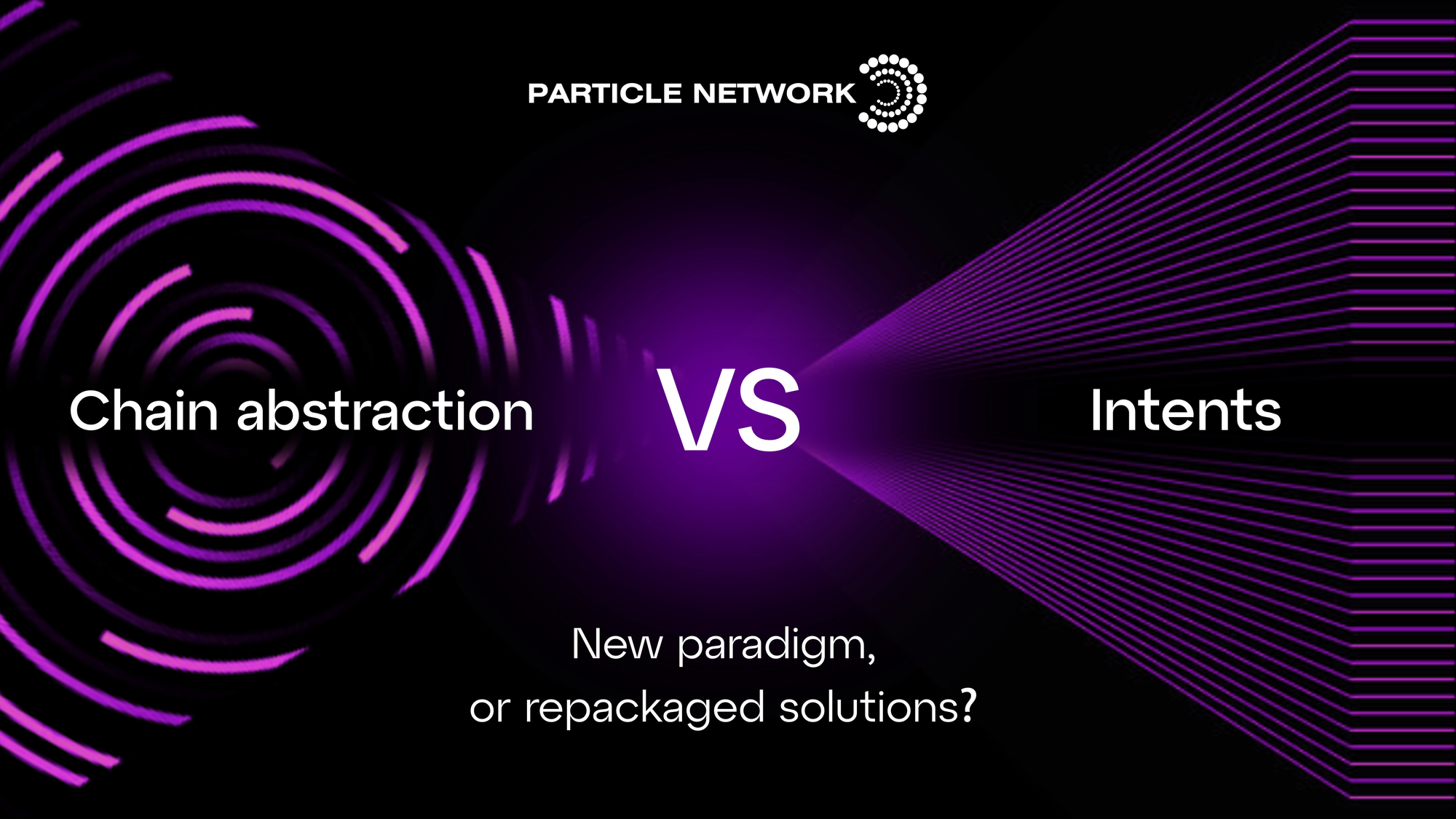Chain Abstraction vs Intents: New Web3 paradigm, or repackaged solutions?

Table of Contents:
Chain abstraction (ChA) is taking Web3’s spotlight as the next step of its development. Due to this, it’s only natural to see it compared to pre-existing technologies—particularly the ones that contributed to its emergence.
Throughout our different blog posts, we’ve proposed crucial theoretical frameworks surrounding ChA. We have:
- Established chain abstraction as “a user experience exempt from the manual processes required to interact with multiple chains”, a definition now broadly used across Web3.
- Developed the multi-layer and comprehensiveness frameworks to classify chain abstraction solutions.
- Repeatedly highlighted the importance of collaboration by different solutions across the technology stack to broadly implement ChA.
However, for those outside our very specialized field, a question remains: what about chain abstraction is new, and how much of it is a repackaging of pre-existing technologies?
This article will explore this question, closely tracking chain abstraction’s relationship to intents, a key technology contributing to ChA. We’ll also revisit ChA’s relationship to interoperability tech, account abstraction, and related foundational solutions along the way, examining their role alongside intents as foundations of chain abstraction.
Intents and their role in chain abstraction
In Web3, the term “intents” is used in multiple ways, to mean different things —much like “chain abstraction.” Essential defines intents as follows:
“Intent: A specification for some off-chain work to be done (in exchange for compensation)”,
OR, in a more technical setting, “An intent is a constraint on the state transition function”.
The first definition showcases the broadness to which intents can be introduced to simplify a user’s path to a desired outcome. For example, a typical intent-centric application is limit orders in DEXs (e.g. CoW Swap, 1inch), which execute a swap once an asset reaches users’ target price. In such a case, the intent could be articulated, for example, as “Swap 100 USDC for ETH if ETH reaches a price of $1000, but only if this happens within the next 2 hours”.
However, in some cases intent executions could span multiple chains. At these times, then, there might be clear similarities between such a system and the experience we now know as chain abstraction. This opens the gate for a genuine questioning of whether ChA is a hype-oriented repackaging of an existent term (something known to happen in Web3), or whether there are new edges to consider when comparing both.
A similar comparison can be made between chain abstraction and other emerging Web3 technologies, such as:
- Account abstraction can allow for users to trigger batched transaction sequences across multiple chains with a single signature, an experience classifiable as chain abstraction.
- Interoperability technologies intrinsically support and, in many cases, facilitate the movement of assets across chains, and can even be used programmatically by other solutions. As such, they could also be said to be a key component of chain abstraction.
So, what about chain abstraction is unique? Is it an umbrella term encompassing multiple technologies?

Next, let’s dive into what chain abstraction constitutes, and where its limits are.
One of the issues in defining and understanding chain abstraction is the fact that, as opposed to intents, account abstraction, and interoperability, ChA cannot be considered a technology per se.
A key element of this definition is the fact that ChA is a user experience. And consequently, individual technologies like the above might contribute to enabling this experience—either temporarily and on their own, or in a sustained manner, as a part of other solutions.
Hence, rather than classifying ChA as an umbrella term encompassing multiple technologies, we can speak about this experience being present in different degrees within various areas of Web3, enabled by these technologies. This earns them the name of foundational chain abstraction solutions.
Within this framework and within the context of Web3, intents can be seen as a technology usable by chain abstraction solutions to drive complex cross-chain workflows and asset movements.

So, is chain abstraction the sole goal of “foundational technologies”?
Yes, and no.
You could argue that there are two goals in improving Web3’s UX:
- Enhancing the UX of blockchains by introducing new technologies or improvements, making them inherently easier to use.
- Enabling chain abstraction across users’ whole experience—what we call a “total implementation of chain abstraction.” We understand that, in a multi-chain world, there will always be a need for technologies that facilitate an experience spanning several chains.

As shown above, certain foundational solutions, like account abstraction, undoubtedly contribute to #1, as do interoperability solutions to #2. However, intents could be found within #1 or #2, or even a mix of both depending on their specific implementation. In many cases, they can even be leveraged by two types of solutions:
- Orchestration solutions: Solutions enabling the creation of multi-chain dApps by coordinating the execution and management of cross-chain operations. This includes projects like Agoric, Socket and Skip. Within orchestration solutions, intents can be used for users to specify their desired outcome, to then be triggered across multiple chains by dApps or any smart contract.
- Comprehensive solutions: Solutions solving several problems at once, enabling chain abstraction in multiple areas within the user experience. This includes products like our own Universal Accounts, NEAR, and Polygon’s AggLayer. These solutions may leverage intents to, e.g., unify users’ liquidity and pool assets together from multiple chains for what, to the user, will feel like a single blockchain transaction.

Furthermore, when it comes to intents solutions, it’s also interesting to note here that some projects developing in this field might:
- Focus on developing intents-related technology alongside use cases that fit directly in either of the above categories (comprehensive or orchestration ChA solutions). For example, Orb Labs primarily focuses on intents, but aims to build a comprehensive chain abstraction solution relying on them.
- Prefer—for diverse reasons—to characterize these solutions purely as “intents” and avoid terminology related to chain abstraction.
The above highlights that there are different approaches to understanding and viewing chain abstraction. This is only natural as ChA emerged as an organic response by a fragmented ecosystem. As such, any ChA solution can contribute to it as a broader goal, finding its niche within it and ultimately aiding in the goal of achieving a complete implementation and unifying the decentralized Web.
Conclusion: The frameworks are the blueprint, not the destination
Wherever the experience of chain abstraction can be found, you can find one or multiple foundational technologies—including intents—enabling it.
Intents are still in early stages of development and, as their implementation accelerates, so will the complexity of the solutions facilitated by them. As this happens, we will likely continue to see similar advancements in ChA, as well as ChA solutions incorporating intents.
Ultimately, the frameworks in this article, including our chain abstraction definition, aim to offer a perspective that allows ChA builders to coordinate and develop in harmony towards a total implementation. We hope to see these being used to guide the synergy between chain abstraction and its foundational technologies. It is only through coordination that we can produce a user-friendly, decentralized web that transcends its original complexities!
Particle Network's Chain Abstraction solutions are 100% free for developers and teams. By integrating them, you can set your project in a path to leveraging chain abstraction.
About Particle Network

Particle Network powers chain abstraction, addressing Web3's fragmentation of users and liquidity. This is enabled by Particle's Universal Accounts, which give users a unified account and balance across all chains.
Share this article
About the author(s)


